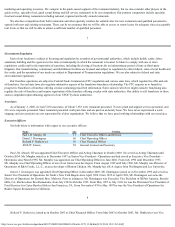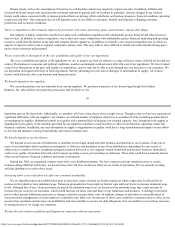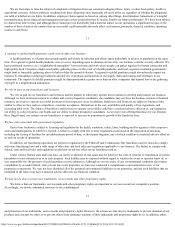Einstein Bros 2005 Annual Report Download - page 17
Download and view the complete annual report
Please find page 17 of the 2005 Einstein Bros annual report below. You can navigate through the pages in the report by either clicking on the pages listed below, or by using the keyword search tool below to find specific information within the annual report.
http://www.sec.gov/Archives/edgar/data/949373/000110465906016136/a06-3178_110k.htm[9/11/2014 10:13:03 AM]
well as from consumers’ decreased use of takeout from other types of restaurants. Growth in the quickservice segment will continue to be driven
by consumers’ demands for value and convenience. Even as they make convenience and speed a top priority, customers also appear to be looking
for new tastes and enhanced décor in quickservice restaurants. Part of the recent growth in quickservice restaurants sales is driven by the growing
popularity of the “quick casual” or “fast casual” restaurants. These restaurants tend to do their highest sales volume at lunch and have higher check
averages (typically in the range of $6.50 to $9.50) than traditional quickservice restaurants. They are characterized by food flavor profiles more in
line with casual dining offerings and décor that tends to deviate from the design of the more traditional quickservice restaurant establishments.
Quickservice menus show a trend toward adding more items for nutrition conscious customers to supplement the already vast selection of menu
items available. Research from the National Restaurant Association indicates that consumers may be interested in even more choices, including
fresh fruit, fresh vegetables, main-dish salads and other items.
According to Fast Casual Magazine, it wasn’ t long ago that you had to look up the definition of “fast casual” to understand the meaning of
this unique restaurant concept that is a hybrid of the fast-food and traditional sit-down eating experiences. Not only is fast-casual food delivered in
a fast, high-quality dining experience, but fast casuals also have been in the fast lane of growth—the entire fast casual segment is expected to
exceed $70 billion in 2006, with more than 300 brands fueling a new restaurant explosion.
Company Overview
We are a leader in the quick casual segment of the restaurant industry. We specialize in high-quality foods for breakfast and lunch in a café
atmosphere with a neighborhood emphasis. Our product offerings include fresh baked bagels and hot breakfast sandwiches, cream cheese and other
spreads, specialty coffees and teas, creative soups, salads and sandwiches, among other things. We operate and license locations primarily under
the Einstein Bros. and Noah’ s brand names, and franchise locations primarily under the Manhattan brand name. We also operate a dough
production facility. We view our primary business as operating, franchising and licensing strong restaurant brands in the marketplace. Our
manufacturing operations are supportive to our main business focus but allow us to leverage our inherent cost structure via third party business and
enhancement of our brands through new product channels.
Financing Transactions
Debt Financing—On July 8, 2003, we issued $160 million in aggregate principal amount of 13% senior secured notes due in 2008 ($160
Million Notes) to replace our $140 million in aggregate principal amount of senior secured increasing rate notes due in 2003. On that same date,
we also entered into a three-year, $15 million senior secured revolving credit facility with AmSouth Bank (AmSouth Revolver).
Equity Recapitalization—In September 2003, we completed an equity recapitalization with our preferred stockholders, who held a substantial
portion of our common stock. Among other things, our Mandatorily Redeemable Series F Preferred Stock was eliminated. In exchange, we issued
57,000 shares of our Mandatorily Redeemable Series Z Preferred Stock (Series Z) to Halpern Denny Fund III, L.P. (Halpern Denny) and we issued
9,380,843 shares of our common stock to Greenlight Capital and affiliates (Greenlight).
21
Debt Redemption and Refinancing—On February 28, 2006, we completed a debt refinancing that redeemed our $160 Million Notes and
retired our $15 million AmSouth Revolver. Our new debt obligations consist of the following:
· $15 million revolving credit facility;
· $80 million first lien term loan;
· $65 million second lien term loan; and
· $25 million subordinated term loan.
$15 Million Revolving Credit Facility—the Revolving Facility has a maturity date of March 31, 2011 and provides for interest based upon the
prime rate or LIBOR plus a margin. The margin may increase or decrease up to 0.25% based upon our consolidated leverage ratio as defined in the
agreement. The initial margin is at prime plus 2.00% or LIBOR plus 3.00%. This facility may be used in whole or in part for letters of credit.
$80 Million First Lien Term Loan—the First Lien Term Loan has a maturity date of March 31, 2011 and provides for a floating interest rate
based upon the prime rate or LIBOR plus a margin. The margin may increase or decrease 0.25% based upon our consolidated leverage ratio as
defined in the agreement. The initial margin is prime plus 2.00% or LIBOR plus 3.00%. The facility is fully amortizing with quarterly principal
reductions and interest payments over the term of the loan as follows:
For the 2006 fiscal year ending January 2, 2007
$1.425 million
For the 2007 fiscal year ending January 1, 2008
$3.325 million
For the 2008 fiscal year ending December 30, 2008
$5.950 million
























